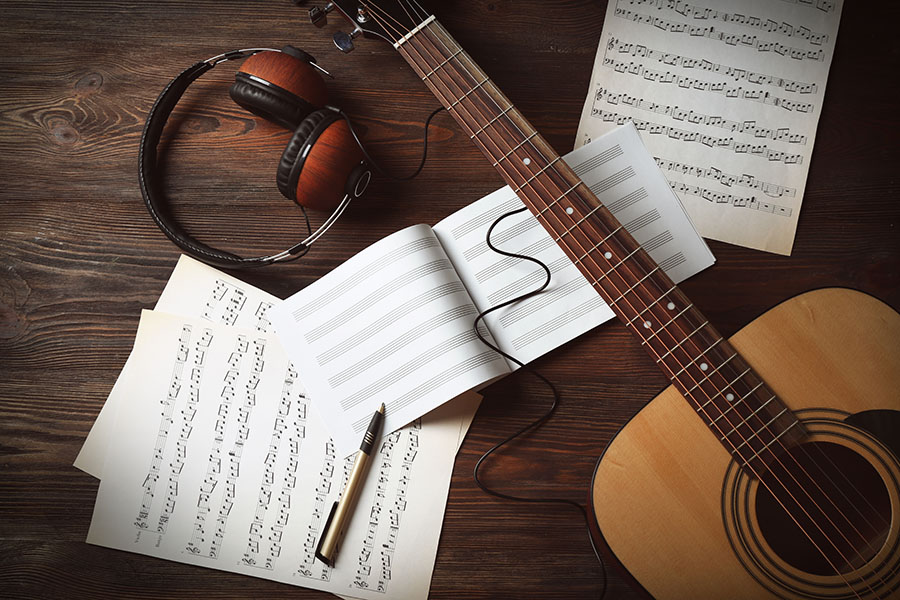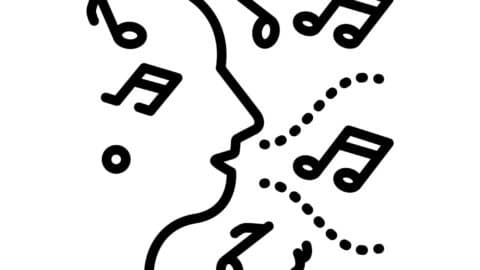Often singer-songwriters are more appreciated than singers who sing cover songs. Many think that singing a song is not particularly creative, even if they admire the vocal performance. But this way of thinking is based on a misconception.
A good singer does not simply imitate a cover song. She makes it her own, her own song. Many stars in rock and pop music became famous, even today, by singing the songs of others. With a lot of wit and creativity, they reworked other people's songs so that they remained associated with their own name afterwards.
Here you might be saying to yourself: Sounds great, but how do I do it? How do I go about making my cover song more than just a song by my favourite star sung by someone else, but more than just a cover song? my Song? Admittedly, there is no patent remedy here, and certainly no guarantee of success. Nevertheless, we have created a little guide for you to help you with your song work. With the aim of helping you to sing your favourite song in such a way that your audience will be You and no longer just a replacement for the original.
Finding the starting point: Visualisation
Song work starts with yourself. First ask yourself: Why this song? After all, it is about a song that awakens in you the need to sing it. There is something about the lyrics, maybe just a word, sung with a special sound, that speaks to you deeply. Something that has to come out, that you want to share with an audience.
An example: the "Hello" with which Adele's song of the same name begins. This first "Hello" sounds almost toneless, somehow lost. "It's me", it continues, making it clear that she is talking on the phone. And: "I was wondering if after all these years you'd like to meet ..." - A very concrete situation, but one that leaves everything that has gone before open. It opens up a space, into her past, perhaps also into your own past as a listener. For many, this introduction immediately evokes images, memories of broken relationships.
If you have found a line in your cover song that resonates with your own personal experience, that awakens strong feelings, moods or inspiring thoughts, then you have already found your starting point. Just take a sheet of paper and a pencil. Write down, in concrete terms: Where are you when you hear these words from the song? Close your eyes and describe what it's like in that place, what your surroundings look like, what time of day or night it is, who else is there, how you feel there.
With this first step, you are already distancing yourself from the original. The images from Adele's music video cease to exist for you. You have transferred the song into your own world of images - be it in connection with real experiences or completely fictitious. This "visualisation" is also important because it creates a direct connection between you and the song lyrics. The star, who until now stood between you and the song lyrics, steps aside, so to speak, and you take his place.
Many singing talents think they have to sing a cover song just like their original. And they do it really well. Nevertheless, they don't succeed in convincing their audience, the enthusiasm remains restrained. That has something to do with the fact that the audience has a fine sense of who is singing.
Schematically speaking, there is a difference between Adele singing "Hello" and you singing "Hello" as Adele, as a kind of mediator or substitute - or you, simply yourself, singing "Hello". So push her, the big star, aside and sing your own "Hello". With your own projection of everything the word means to you. It will sound different, and you are in a different position: you have the attention of the audience, who are eager to hear what happens next.
"Your song interpretation: the five W-questions".
The five W-questions are well-known from the acting world. They can help you determine the scenario in which your song should take place. And your role in this scenario. When you stand in front of an audience and sing, you are always an actor. You put yourself completely into the lyrics of your song, become the main actor of the story it tells, or the compassionate narrator, as the case may be.
This brings us to the first W-question: Who are you in the song? Notes help you determine how old you are, what your life situation is right now, how you got there.
Secondly: Why do you sing the song, what do you want to achieve? Adele once said in an interview about her song "Hello": She had to write it so that all her past loves, with whom she no longer has contact, could hear her. Her need to be heard is the underlying reason from beginning to end.
Thirdly: What do you sing in the song, what is the message of the lyrics? There are dramatic turning points in Adele's lyrics: A few lines after her first "Hello, it's me", it turns out that the person she's talking to can't hear her. Maybe she's just going to voicemail, or her call isn't coming in at all. While talking to herself, she then realises the enormous distance to her former lover: "a million miles". Finally, in the chorus, the "Hello" becomes an unbridgeable, desperate "Hello from the other side", which Adele sings out in a high-pitched voice.
Study the lyrics of your song like a piece of literature and interpret them. With the difference that there is no right and wrong, but only you and the lyrics: text and subtext, sequence of events, images that come to your mind. That sounds demanding, more suitable for songs like Adele's, which is actually something like a little musical drama. But even if you sing a party song, it depends on your projection: on the depth and the imagery you give to the lines of your song.
Fourth: Where are you while you sing? Adele sees herself in a remote country house. You might be somewhere else entirely. Draw an accurate picture of where you are and what you are doing while singing the lyrics. When Adele sings her "Hello from the other side", she has left the house and is standing outside.
Fifth: When Does all this take place, in what time? Also tell yourself a story about what happened before and what you will face afterwards. In Adele's case, a corded telephone and old furniture give clues about the time. And flashbacks with scenes from a previous relationship point to her past.
Speech sample
With this preliminary work, you have established your own setting for your song and your role in it. In the next step, it makes sense to speak the lyrics of your song - no, not to sing them yet, but to speak them. Like an actor at a theatre rehearsal: take your notes and visualise the content you have worked out for each line of the song.
Let yourself be guided by these contents, images and feelings as you speak the text, with a vocal sound, accentuation and voice leading that suits it. Depending on where you are in the dramaturgy of the song, this can be an agitated speaking in a high voice, it can be a soulful breath, an agonised exclamation, a quiet narration or much more.
Again, by way of example, maybe your "Hello" is joyful and expectant, while Adele's "Hello" sounds depressed right from the start. Let's assume that your goal in singing the song is not to come to terms with an unhappily broken relationship. Instead, you want your former lover back, to make a new start. Then your "Hello from the other side" will not sound resigned, but rather passionate and combative.
On the way to your song
Now it's a matter of transferring your spoken word with all the expression you have given it into the melody and rhythm of the song. Take all the freedom you need to do this:
- Transpose the song into a key that suits your voice and your performance. If you sing freely, without the original or the playback in your ear, you will notice very quickly in which key your singing can develop best. From there, you determine the key for your song - for your instrument or for your playback.
- You can also change the melody of the song. If melodic ornaments, particularly accentuated high notes or note lengths do not fit your speech melody, then change them. If you find it difficult to find notes that fit harmonically into the chord progressions of the song, improvisation techniques can help.
- Experiment with rhythm and tempo. Again, starting from the voice style you have arrived at, add a rhythmic hand-clapping or shaker. With the help of a drum machine, you can then set your own rhythm for the song.
Try out different keys, melodic variations, faster or slower tempos. Many amateur singers don't do this, out of sheer adoration for the musical original they cover and want to sing as faithfully as possible.
Admittedly, for singing beginners it can be motivating and instructive to imitate a role model. In the long run, however, it inhibits their own musical development. And it is also not purposeful if they want to sing in front of an audience.
If you don't want to be an imitator or make dance music, the standard for your cover song is not: it's good if you sound like the original. Otherwise, your audience would be better off listening to the original at a DJ party or staying at home.
Your song is good when it leaves your audience feeling enriched. Because your audience has heard the story of the song from a new perspective. Or you have surprised your listeners with an unexpected emotion. Or because you blew them away - yourself, with your power, in a role that you defined for the song. Not as a stand-in for your favourite singer.
Nevertheless, we want to hear and see her now with her music video: Adele with her song "Hello", which became an internationally acclaimed number 1 hit a few years ago:
Your song work begins with yourself. Accompanying this is also work on your vocal expression. If you are looking for vocal exercises to build up your voice, then look at like to join my online singing courses.






